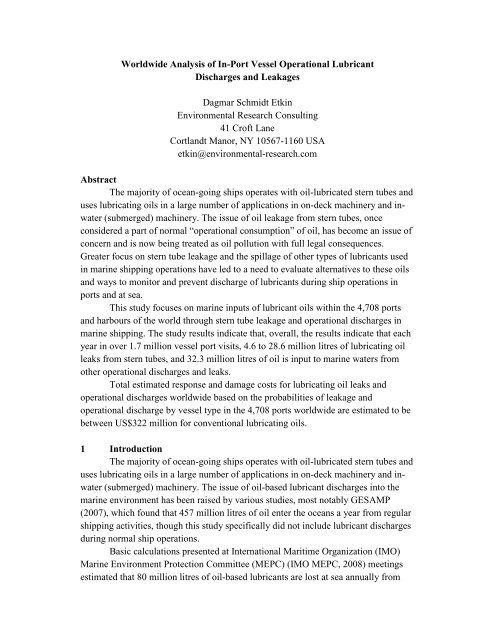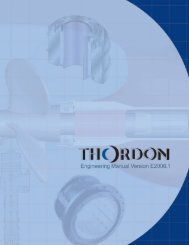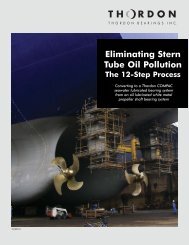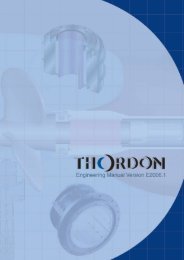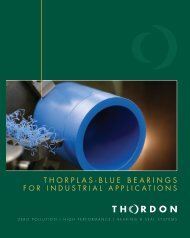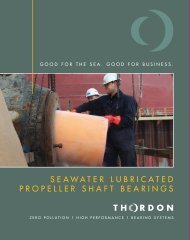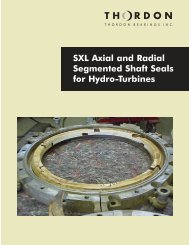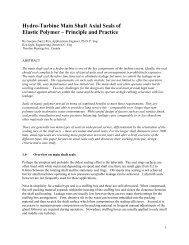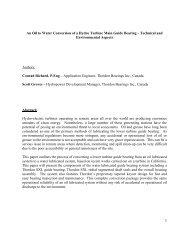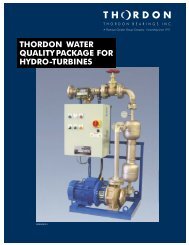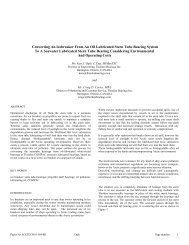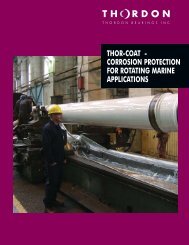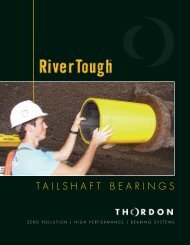Worldwide Analysis of In-Port Vessel ... - Thordon Bearings
Worldwide Analysis of In-Port Vessel ... - Thordon Bearings
Worldwide Analysis of In-Port Vessel ... - Thordon Bearings
You also want an ePaper? Increase the reach of your titles
YUMPU automatically turns print PDFs into web optimized ePapers that Google loves.
<strong>Worldwide</strong> <strong>Analysis</strong> <strong>of</strong> <strong>In</strong>-<strong>Port</strong> <strong>Vessel</strong> Operational LubricantDischarges and LeakagesDagmar Schmidt EtkinEnvironmental Research Consulting41 Cr<strong>of</strong>t LaneCortlandt Manor, NY 10567-1160 USAetkin@environmental-research.comAbstractThe majority <strong>of</strong> ocean-going ships operates with oil-lubricated stern tubes anduses lubricating oils in a large number <strong>of</strong> applications in on-deck machinery and inwater(submerged) machinery. The issue <strong>of</strong> oil leakage from stern tubes, onceconsidered a part <strong>of</strong> normal “operational consumption” <strong>of</strong> oil, has become an issue <strong>of</strong>concern and is now being treated as oil pollution with full legal consequences.Greater focus on stern tube leakage and the spillage <strong>of</strong> other types <strong>of</strong> lubricants usedin marine shipping operations have led to a need to evaluate alternatives to these oilsand ways to monitor and prevent discharge <strong>of</strong> lubricants during ship operations inports and at sea.This study focuses on marine inputs <strong>of</strong> lubricant oils within the 4,708 portsand harbours <strong>of</strong> the world through stern tube leakage and operational discharges inmarine shipping. The study results indicate that, overall, the results indicate that eachyear in over 1.7 million vessel port visits, 4.6 to 28.6 million litres <strong>of</strong> lubricating oilleaks from stern tubes, and 32.3 million litres <strong>of</strong> oil is input to marine waters fromother operational discharges and leaks.Total estimated response and damage costs for lubricating oil leaks andoperational discharges worldwide based on the probabilities <strong>of</strong> leakage andoperational discharge by vessel type in the 4,708 ports worldwide are estimated to bebetween US$322 million for conventional lubricating oils.1 <strong>In</strong>troductionThe majority <strong>of</strong> ocean-going ships operates with oil-lubricated stern tubes anduses lubricating oils in a large number <strong>of</strong> applications in on-deck machinery and inwater(submerged) machinery. The issue <strong>of</strong> oil-based lubricant discharges into themarine environment has been raised by various studies, most notably GESAMP(2007), which found that 457 million litres <strong>of</strong> oil enter the oceans a year from regularshipping activities, though this study specifically did not include lubricant dischargesduring normal ship operations.Basic calculations presented at <strong>In</strong>ternational Maritime Organization (IMO)Marine Environment Protection Committee (MEPC) (IMO MEPC, 2008) meetingsestimated that 80 million litres <strong>of</strong> oil-based lubricants are lost at sea annually from
stern tubes alone. However there have been as yet no authoritative figures on this orother lubricant pollution to guide delegates and policymakers.2 MethodologyThis study focuses on operational discharges <strong>of</strong> lubricant oils within ports andharbors including discharges that occur during transit within the harbor or port andwhile moored at docks. The study excludes inputs that occur en-route or on the openocean, since the monitoring and recording <strong>of</strong> small discharges at sea is relatively poormaking any data analyses on these types <strong>of</strong> inputs extremely inaccurate.The study also only includes the leakage, and operational discharge <strong>of</strong> theselubricants in their application and use in marine shipping (i.e., on the shipsthemselves as stern tube lubricants, gear lubricants, etc.). It specifically excludesaccidental spills from vessels (e.g., during a collision) or spills <strong>of</strong> stored lubricant oilsat shore-based facilities or the transport <strong>of</strong> these lubricants as cargo by tank ships,tank barges, railroad, or tanker truck, or inputs from land-based lubricants usingsimilar machinery, e.g., cranes, as those considered on vessels. Spills are defined asdiscrete events in which oil is released accidentally, or, occasionally, intentionallythrough dumping or vandalism, over the course <strong>of</strong> a relatively short amount <strong>of</strong> time.Spillage can occur during transfers (e.g. in refilling lubricating oil vesicles), as aresult <strong>of</strong> accidents, such as a collisions, allisions, or groundings, or there is significantstructural damage to the vessel.Two types <strong>of</strong> lubricating oil inputs are included in the study – stern tubeleakages and operational discharges. <strong>In</strong>puts are estimated based on port visit data byvessel type for 4,708 ports worldwide, as well as by nation.Lubricant spills and releases come from a number <strong>of</strong> different sources on avessel and it is worthwhile considering the two separately. Focus in the past hasalways been upon the highly visible spills that take place, with hydraulic fluids beingthe primary area <strong>of</strong> concern, as these systems operate at high pressures and high flowrates. They incorporate elastomer seals and flexible hoses that are subject to wear andabrasion, and also to fatigue with continual pressure fluctuations. When a hose bursts,there is a significant amount <strong>of</strong> oil released onto the deck and then onto the sea,where its presence is very obvious. Similarly leaks from smaller items <strong>of</strong> deckequipment such as winches and windlasses are very evident. The gearboxes on thisequipment are not generally pressurised, but leaking seals on shafts result in gear oilleakage onto the deck and again it makes its way over the side. These occasionalspills or leaks are easily evident because they result in a sheen on the water surface –in port, at least.2.1 Stern Tube LeakageStern tube leakage is significant source <strong>of</strong> lubricant oil inputs to the marineenvironment. A 2001 study commissioned by the European Commission DG JointResearch Centre (Pavlakis et al., 2001) reported on the extent <strong>of</strong> ship-based oil
pollution in the Mediterranean Sea. The study revealed that routine unauthorizedoperational discharges <strong>of</strong> oil created more pollution than accidental spills. Stern tubeleakage was identified as a major component <strong>of</strong> these discharges.The stern tube <strong>of</strong> a ship is the connection between the engine and thepropeller. <strong>In</strong>side the stern tube is the propeller shaft, which is driven by the ship’sengine and rotates to turn the propeller round. The stern tube is one <strong>of</strong> the parts <strong>of</strong> aship below the waterline that contains a significant amount <strong>of</strong> lubricant oil.Generally, stern tube shaft seals are the only barrier between the oil in thestern tube and the marine environment. A propeller shaft sealing system is designedto prevent the entry <strong>of</strong> water into the stern tube where it could damage the bearings.The seal is also designed to prevent the leakage <strong>of</strong> lubricating oil into marine waters.Ideally, in this closed system there should be no leakage to the water.According to the US Environmental Protection Agency (EPA, 1999), “oillubricated stern tube seals cannot release oil to the environment under normal shipoperations”. Some common system design features to prevent releases include :Use <strong>of</strong> multiple sealing rings at both the inboard and outboard stern tube ends;Methods to maintain pressure in the stern tube cavity below that <strong>of</strong> the seawater pressure outside to ensure that in the event <strong>of</strong> leakage, water will leak inrather than any lubricant leaking out; andPositive methods for determining stern tube seal leakage.Because these seals can become worn over time or damaged by marine debris,particularly rope and fishing lines, oil leakage can occur. Anecdotal and empiricalevidence from stern tube lubricant consumption supports this contention. The issue <strong>of</strong>oil leakage from stern tubes, once considered a part <strong>of</strong> normal “operationalconsumption” <strong>of</strong> oil, has become an issue <strong>of</strong> concern as it is now being treated as “oilpollution” with the same legal consequences as spills in many jurisdictions (e.g.,under the US EPA 2008 National Pollution Discharge Elimination System or“NPDES” regulations implemented in 2009).There are no completely reliable estimates or methodologies for estimation <strong>of</strong>stern tube leakage. Clearly, stern tube leakage varies by vessel type, condition, age,and maintenance. Based on on-site inspections, leakage rates are observed to varywith vessel age, especially for stern tubes in older vessels that have been damaged byropes or fishing nets, and for which maintenance may be a lower priority. There areanecdotal reports <strong>of</strong> newer vessels rarely requiring stern tube lubricant top-<strong>of</strong>f.Theoretically, with a closed stern tube system there should be no leakage, butobservations indicate that there is “rarely a perfectly sealed system” and that there isalways some small amount <strong>of</strong> leakage. It is also not uncommon for older vessels torequire 5 – 10 litres per day.The leakage rate for stern tubes has been widely reported as “6 litres per day”for a vessel <strong>of</strong> 1,000 DWT, with higher rates for larger vessels and lower rates forsmaller vessels (Thorndon, 2004; Carter, 2009; Ahlbom and Duus, 2006; IMO
MEPC, 2008). This reported leakage rate has been explained as being based on themaximum allowable leakage for certification in Lloyd’s Registry Class Society SealType Approvals for vessels <strong>of</strong> at least 1,000 deadweight tonnage (DWT), though allclassification societies mention leak tests and “zero tolerance” for leakage. Accordingto the Clean Shipping Project <strong>of</strong> Sweden (Ahlbom and Duus, 2006), there is a “rule <strong>of</strong>thumb” that up to one percent <strong>of</strong> the thickness in millimeters <strong>of</strong> the stern tube seal isan acceptable leakage level when counted as litres per 24-hour period. For a 600 mmseal, this means 6 litres per day. To put these leakage rates into perspective, it isinstructive to consider the degree to which such discharges may be noticed by portauthorities if not by vessel operators. <strong>In</strong> the US, the acceptable discharge limit (as per40 Code <strong>of</strong> Federal Register (CFR) part 110) is that quantity that does not create anoticeable sheen (i.e., a rainbow sheen with an average thickness <strong>of</strong> 0.0003 mm or asilver sheen with an average thickness <strong>of</strong> 0.0001 mm). One litre <strong>of</strong> oil would spreadto a rainbow sheen covering about three m 2 . Six litres would cover 20 m 2 . This wouldlikely be noticed by port <strong>of</strong>ficials and require a response.An analysis <strong>of</strong> data on oil consumption sourced from a lubricant supplierindicates a range <strong>of</strong> average daily stern tube lubricant consumption rates for differentvessels. The average rate across vessel types is 2.6 litres per day, but ranges from lessthan 1 litre per day to 20 litres per day. The results <strong>of</strong> the stern tube consumption dataanalysis are summarized in Table 1.Table 1. Average Daily Consumption <strong>of</strong> Stern Tube Lubricants<strong>Vessel</strong> Type(s) 1DailyConsumptionBarge Carrier20 litres/dayIWW Oil Tanker11 litres/dayNavy Ships10 litres/dayGeneral Cargo Ship7 litres/dayBulk Carrier; Passenger/Ro-Ro Cargo Ship6 litres/dayContainer Ship; Tender; Live Stock Carrier5 litres/dayHeavy Load Carrier; Research <strong>Vessel</strong>; Crude Oil Tanker; Refrigerated Cargo Ship;4 litres/dayChemical Tanker; Container Ro-Ro Cargo Ship; TrawlerPusher Tug; Hopper Dredger; Palletised Cargo Ship; Oil Products Tanker; Wood3 litres/dayChips Tanker; Chemical/Oil Products Tanker; Vehicles Carrier; LPG TankerOffshore Supply Ship; Passenger Ferry; Self-Discharging Bulk Carrier; OffshoreTug/Supply Ship; Fish Carrier; Fishing <strong>Vessel</strong>; Sail Training Ship; Passenger Cruise 2 litres/dayShip; Standby Safety <strong>Vessel</strong>; Cement Carrier; Asphalt/Bitumen TankerOffshore Support <strong>Vessel</strong>; Bulk/Oil Carrier; LNG Tanker1 litre/dayBuoy/Lighthouse <strong>Vessel</strong>; Cable Layer; Crane Ship; Dredger; Fishery Support <strong>Vessel</strong>;Live Fish Carrier; Motor Hopper; Offshore Processing Ship; Ore Carrier;Passenger/General Cargo Ship; Patrol <strong>Vessel</strong>; Pipe Layer; Platform; Pollution Control 0 litres/day<strong>Vessel</strong>; Pontoon; Stone Carrier; Trans Shipment <strong>Vessel</strong>; Water Tanker; WellStimulation <strong>Vessel</strong>; Work/Repair <strong>Vessel</strong>1 Note that vessels such as barge carriers and inland waterway (IWW) oil tankers may be consuminglarger amounts <strong>of</strong> stern tube lubricants due to the degree to which the vessels are submerged.
<strong>In</strong> the analyses in this report, the value <strong>of</strong> 6 litres per day is applied as anaverage upper limit and 2.6 litres per day is applied as an average rate. Note thatthere are a number <strong>of</strong> vessel types for which no stern tube lubricant consumption isreported in this data. This may be a matter <strong>of</strong> not having samples from thesecategories, or in some cases there may actually be no leakage.2.2 Operational <strong>In</strong>puts <strong>of</strong> Deck Machinery<strong>In</strong> addition to spills and stern tube leakage, there are “operational inputs” <strong>of</strong>lubricant oils that occur due to continuous low-level discharges and leakages thatoccur during normal vessel operations in port. The sources <strong>of</strong> operational dischargesinclude deck machinery and in-water (submerged) machinery.Estimates <strong>of</strong> operational discharges from these operations in this study arebased on the “consumption” <strong>of</strong> oil reported to a lubricant supplier in a five-yearcollection <strong>of</strong> data on daily usage <strong>of</strong> lubricating oils while in port and underway. Noother comparable vessel type- and machinery-specific data were available.Data were adjusted by removing out-lying values that greatly exceededaverage values for each vessel and machinery type on the assumption that thesewould rightly be spills rather than routine operational discharges. These data wouldtend to underestimate inputs because the voluntary reporting implies that there is abias towards the more conscientious operators. The assumption is that the oil replaceddaily during the port visit represents the amount <strong>of</strong> leakage in the port. Leakage at seais not included herein since that oil would have been replaced during the voyage.Average per-port visit inputs from deck machinery across all vessel types areshown in Table 2. The oil that is used on deck-based machinery can enter the waterthrough rain run<strong>of</strong>f or during deck washing activities.Table 2. Average <strong>In</strong>put <strong>of</strong> Lubricants from Deck-Based Machinery in <strong>Port</strong>Deck Machinery TypeAverage <strong>In</strong>put per <strong>Port</strong> Visit (litres)Deck crane gears 0.073Dredge pump shaft bearings 0.033Gear-driven mooring winches 0.102Gear-driven windlasses 0.024Hose-handling cranes 0.007Hydraulic system prov cranes 0.022Hydraulic deck machinery 0.197Hydraulic windlass mooring winches 0.019Hydraulic capstans 0.030Hydraulic cranes 0.096Hydraulic hatch systems 0.126Hydraulic mooring winches 0.110Hydraulic split systems 0.007Hydraulic system stern ramps 0.027Miscellaneous hydraulic systems 0.210Ro-ro hydraulic systems 0.007
Table 2. Average <strong>In</strong>put <strong>of</strong> Lubricants from Deck-Based Machinery in <strong>Port</strong>Deck Machinery TypeAverage <strong>In</strong>put per <strong>Port</strong> Visit (litres)Hydraulic water-tight doors 0.004Hydraulic windlasses 0.095Towing winches 0.005Towing winch gears 0.003Hydraulic trim tabs 0.025Tugger winches 0.010TOTAL 1.232Again, inputs vary by vessel type. Note that not all vessel types have the machinerylisted and will thus not have all discharge types listed. Average inputs <strong>of</strong> lubricating oil fromdeck-based machinery by vessel type are shown in Table 3. It is estimated that about 10% <strong>of</strong>the oil enters the water through run<strong>of</strong>f or wash<strong>of</strong>f. The rest would adhere to the deck andequipment. This may well be an underestimate <strong>of</strong> input into the water.Table 3. On-Deck Machinery: Lubricant Consumption per <strong>Vessel</strong> <strong>Port</strong> Visit<strong>Vessel</strong> TypeAverage Consumption per <strong>Port</strong> Visit (litres)Bulk Carrier 57.92Container Ship 57.70General Cargo 52.14Chemical Tanker 51.00Cement Carrier 42.38Passenger/Ro-Ro 39.96Ro-Ro Cargo Ship 36.90Self Disch. Bulk 30.47Crude Oil Tanker 30.18Pontoon 25.00ChemicalTanker 24.79Dredger 23.60Refrig. Cargo 21.03Oil Prod.Tanker 20.12Tug 20.00Ore Carrier 19.00Offshore Tug 13.40Passenger /Cruise 12.50Motor Hopper 12.33Heavy Load Carr. 11.67Fishing <strong>Vessel</strong> 11.50Crane Ship 11.00Container Ro-Ro 10.87Vehicles Carrier 10.17Trans Shipment 9.50Wood Chip Carr. 9.50Offshore Supply 8.56Bulk/Oil Carrier 7.00Dredger 7.00Palletised Cargo 7.00Research <strong>Vessel</strong> 6.67Live Fish Carrier 6.00Passenger/ Cargo 5.25LPG Tanker 5.05
Table 3. On-Deck Machinery: Lubricant Consumption per <strong>Vessel</strong> <strong>Port</strong> Visit<strong>Vessel</strong> TypeAverage Consumption per <strong>Port</strong> Visit (litres)Trawler 3.67Fishery Support 3.18Buoy/Lighthouse 3.00Standby Safety 3.00Offshore Support 2.50Platform 1.30LNG Tanker 1.00Patrol <strong>Vessel</strong> 1.00Pipe Layer 1.002.3 Operational <strong>In</strong>puts from Submerged Machinery<strong>In</strong> addition to inputs from machinery on vessel decks, there are also moredirect inputs from in-water (submerged) machinery. There are a number <strong>of</strong> systemssituated below the waterline which require to be lubricated. The main ones toconsider are the stern tube bearing, thruster gearboxes, and horizontal stabilisers. All<strong>of</strong> these have pressurised lubricating oil systems where the pressure is maintained at ahigher pressure than the surrounding sea. The reason for this is to ensure that nosignificant amount <strong>of</strong> water enters the oil system, where it would compromise thereliability <strong>of</strong> the unit. The corollary is that any leakage which does take place is fromthe unit outwards into the sea. When the elastomer seals on propeller shafts orthruster bearings are in good condition this is a small (but continuous) amount <strong>of</strong>leakage, but any seal wear or damage increases the amount. The lubricant is releasedwell below the waterline into an area <strong>of</strong> turbulence (the propeller) which means that itis immediately dispersed and no giveaway sheen occurs on the water surface.Average inputs <strong>of</strong> lubricant oils from these in-water machinery sources shownin Table 4, and are detailed by vessel type in Table 5. It is assumed that all oil thatleaks or discharges from these sources enters the water. Note that not all vessel typeshave the machinery listed and will thus not have all discharge types listed.Table 4. Average <strong>Port</strong> Visit <strong>In</strong>put <strong>of</strong> Lubricants from Submerged MachinerySubmerged Machinery TypeAverage <strong>In</strong>put per <strong>Port</strong> Visit (litres)Aquamaster – Gears 0.12Bow Thruster 1.10Bow Thruster Gears 0.85CPP System Gears 0.67Fin Stabiliser Gear 0.13Gears - Azimuth Thrusters 0.70Hydraulic Fin Stabiliser 0.24Hydraulic Thrusters/ CPP 1.14Hydraulics - Azimuth Thrusters 0.13Steering Thrusters 0.04Stern Thruster 2.39Stern Thruster Gears 0.21
Table 4. Average <strong>Port</strong> Visit <strong>In</strong>put <strong>of</strong> Lubricants from Submerged MachinerySubmerged Machinery TypeAverage <strong>In</strong>put per <strong>Port</strong> Visit (litres)Thruster Gears 0.77Under Water Pump Shaft Bearing 0.03Waterjet – Hydraulic 0.03Waterjet Gears 0.03TOTAL 8.58Table 5. <strong>In</strong>-Water Machinery: Estimated Lubricant Consumption per <strong>Port</strong> Visit<strong>Vessel</strong> TypeAverage Consumption per <strong>Port</strong> Visit (litres)Ro-Ro Cargo Ship 28.77Passenger/Ro-Ro 27.03General Cargo 26.28Offshore Tug 25.68Palletised Cargo 23.00Barge Carrier 20.00Offshore Supply 19.09Oil Prod.Tanker 18.03Offshore Support 17.08Passenger /Cruise 17.01Motor Hopper 17.00Vehicles Carrier 16.71Research <strong>Vessel</strong> 15.39LPG Tanker 14.74Tug 13.58Crane Ship 13.30Chemical Tanker 12.00Container Ship 11.92IWW Oil Tanker 10.50Naval 10.00Pollution Control 10.00Crude Oil Tanker 8.70Bulk Carrier 7.79Cement Carrier 7.42Standby Safety 6.76Refrig. Cargo 6.63Self Disch. Bulk 6.51Trawler 6.50Dredger 6.33Patrol <strong>Vessel</strong> 6.00Livestock Carrier 5.67Sail Training Ship 5.60Heavy Load Carr. 5.00Tender 5.00Water Tanker 5.00Pusher Tug 4.75Container Ro-Ro 4.50Offshore Process 4.11Pipe Layer 4.00Well Stimulation 4.00Passenger Ferry 3.33Stone Carrier 3.33Fishing <strong>Vessel</strong> 3.00
Table 5. <strong>In</strong>-Water Machinery: Estimated Lubricant Consumption per <strong>Port</strong> Visit<strong>Vessel</strong> TypeAverage Consumption per <strong>Port</strong> Visit (litres)Wood Chip Carr. 2.75Fishery Support 2.50Buoy/Lighthouse 2.00Cable Layer 2.00Fish Carrier 2.00Asphalt Tanker 1.50Work/Repair 1.25Bulk/Oil Carrier 1.00LNG Tanker 1.00For deck machinery-sourced discharges, bulk carriers, and container ships hadthe highest inputs. Hydraulic deck machinery was the largest source <strong>of</strong> lubricating oildischarge. For in-water machinery-sourced discharges, ro-ro cargo, ro-ropassenger/cargo, and general cargo ships had the highest input rates. Stern thrusterswere the largest input source across all vessel types.2.4 Estimating Discharge Volumes in <strong>Port</strong> and Harbour AreasDischarge volumes were developed based on the types <strong>of</strong> vessels andlubricant application types (e.g., stern tube vs. gear) based on five years <strong>of</strong> data <strong>of</strong> inportlubricant replacement rates from a lubricant supplier. These rates <strong>of</strong> dischargewere then applied on the basis <strong>of</strong> five years <strong>of</strong> reported vessel visits by port for all4,708 ports worldwide. Stern tube leakage was considered separately from the othertypes <strong>of</strong> operational discharges.3 ResultsTable 6 shows lubricant operational discharges for top ten ports and Table 7 showslubricant inputs for all nations, assuming maximized stern tube leakage rates.Table 6. Annual Lubricant <strong>In</strong>put – Top Ten <strong>Port</strong>sCountry/Territory <strong>Port</strong>Annual Lube Oil <strong>In</strong>puts in <strong>Port</strong>s (litres)Stern Tube Other Operational TotalSingapore Singapore 892,234 823,657 1,715,891Turkey Istanbul 787,990 912,282 1,700,272Gibraltar Gibraltar 668,309 626,562 1,294,871Germany Brunsbuttel 480,679 604,036 1,084,715Netherlands Rotterdam 482,222 562,660 1,044,882China Hong Kong 509,250 520,885 1,030,135Korea, Republic <strong>of</strong> Busan 389,508 410,161 799,669Belgium Antwerp 263,186 286,689 549,875China Shanghai 269,707 272,884 542,591Taiwan Kaohsiung 253,375 241,438 494,813
Table 7. Estimated Annual Lubricant <strong>Port</strong> <strong>In</strong>puts – by NationCountry/TerritoryAnnual Lube Oil <strong>In</strong>puts in <strong>Port</strong>s (litres)Stern Tube Other Operational TotalAland 4,186 7,576 11,762Albania 35,198 55,982 91,180Algeria 154,453 182,697 337,150American Samoa 1,891 2,524 4,415Angola 22,838 36,007 58,845Antarctica 29 42 71Antigua and Barbuda 24 34 58Argentina 118,319 96,599 214,918Aruba 1,054 991 2,045Australia 424,549 374,357 798,906Azerbaijan 96 132 228Azores 22,906 24,613 47,519Bahamas 54,652 78,662 133,314Bahrain 386 335 721Bangladesh 32,719 33,287 66,006Barbados 17 18 35Belgium 494,290 636,438 1,130,728Belize 7,532 12,476 20,008Benin 15,816 14,833 30,649Bermuda 17 13 30Brazil 509,298 434,230 943,528British <strong>In</strong>dian Ocean Territory 95 85 180Brunei Darussalam 11,870 10,160 22,030Bulgaria 73,118 87,926 161,044Cambodia 7,783 7,900 15,683Cameroon 16,813 17,292 34,105Canada 251,926 223,916 475,842Canary Islands 153,127 178,295 331,422Cape Verde 26,111 37,949 64,060Cayman Islands 565 439 1,004Chile 157,739 151,233 308,972China 1,834,020 1,835,829 3,669,849Colombia 178,806 145,476 324,282Comoros 638 811 1,449Congo 14,539 18,111 32,650Congo, The DRC 8,341 8,998 17,339Cook Islands 156 227 383Costa Rica 37,422 37,190 74,612Cote D'ivoire 42,318 44,750 87,068Croatia 60,342 77,028 137,370Cuba 9,112 8,831 17,943Cyprus 82,796 116,790 199,586Czech Republic 65 44 109Denmark 284,814 371,981 656,795Djibouti 14,534 15,121 29,655Dominica 70 83 153Dominican Republic 47,436 59,467 106,903East Timor 1,310 1,961 3,271Ecuador 51,594 40,976 92,570Egypt 510,736 495,591 1,006,327
Table 7. Estimated Annual Lubricant <strong>Port</strong> <strong>In</strong>puts – by NationCountry/TerritoryAnnual Lube Oil <strong>In</strong>puts in <strong>Port</strong>s (litres)Stern Tube Other Operational TotalEl Salvador 11,158 9,759 20,917Equatorial Guinea 2,213 2,378 4,591Eritrea 1,742 2,291 4,033Estonia 88,001 118,653 206,654Falkland Islands (Malvinas) 4,928 5,253 10,181Faroe Islands 7,120 9,769 16,889Fiji 10,196 12,406 22,602Finland 344,712 502,486 847,198France 580,966 757,001 1,337,967French Guiana 3,522 4,185 7,707French Polynesia 14,051 21,913 35,964French Southern Territories 8 10 18Gabon 11,832 12,227 24,059Gambia 2,046 2,084 4,130Georgia 32,152 38,241 70,393Germany 1,135,122 1,387,392 2,522,514Ghana 30,413 29,308 59,721Gibraltar 668,309 626,562 1,294,871Greece 367,896 485,192 853,088Greenland 1,810 1,964 3,774Grenada 378 603 981Guadeloupe 30,595 48,007 78,602Guatemala 49,272 54,896 104,168Guinea 9,656 7,702 17,358Guinea-Bissau 2,279 2,499 4,778Guyana 11,788 13,775 25,563Haiti 12,857 16,465 29,322Honduras 28,242 36,221 64,463Hungary 2 1 3Iceland 17,369 19,320 36,689<strong>In</strong>dia 408,114 375,972 784,086<strong>In</strong>donesia 733,633 753,551 1,487,184Iran (Islamic Republic Of) 72,899 68,931 141,830Iraq 17,958 23,662 41,620Ireland 132,384 177,075 309,459Isle Of Man 5,377 7,396 12,773Israel 84,558 96,821 181,379Italy 1,080,499 1,557,218 2,637,717Jamaica 38,723 44,550 83,273Japan 1,824,700 1,855,642 3,680,342Jordan 22,309 22,819 45,128Kazakhstan 22 33 55Kenya 20,990 22,591 43,581Kiribati 187 261 448Korea, D.P.R.O. 7,348 7,107 14,455Korea, Republic Of 1,112,074 1,172,092 2,284,166Kuwait 25,861 22,568 48,429Latvia 131,831 168,687 300,518Lebanon 47,954 57,507 105,461Liberia 4,127 5,042 9,169Libyan Arab Jamahiriya 34,616 37,299 71,915
Table 7. Estimated Annual Lubricant <strong>Port</strong> <strong>In</strong>puts – by NationCountry/TerritoryAnnual Lube Oil <strong>In</strong>puts in <strong>Port</strong>s (litres)Stern Tube Other Operational TotalLithuania 77,201 102,097 179,298Madagascar 12,901 15,010 27,911Madeira 10,772 15,573 26,345Malaysia 536,675 547,924 1,084,599Maldives 7,466 9,696 17,162Malta 98,122 123,804 221,926Marshall Islands 137 117 254Martinique 14,645 18,309 32,954Mauritania 13,688 11,426 25,114Mauritius 17 14 31Mayotte 3,323 3,998 7,321Mexico 189,832 225,750 415,582Micronesia 408 289 697Monaco 150 409 559Montenegro 18,733 24,662 43,395Morocco 119,592 152,774 272,366Mozambique 20,807 21,612 42,419Myanmar (Burma) 9,448 11,892 21,340Namibia 8,851 9,084 17,935Netherlands 827,455 1,049,775 1,877,230Netherlands Antilles 21,868 30,888 52,756New Caledonia 54 79 133New Zealand 116,974 116,383 233,357Nicaragua 5,975 5,348 11,323Nigeria 61,126 53,779 114,905Northern Mariana Islands 3,929 4,647 8,576Norway 714,445 942,344 1,656,789Oman 58,944 55,228 114,172Pakistan 48,077 45,333 93,410Palau 229 350 579Panama 81,568 83,163 164,731Papua New Guinea 21,979 25,608 47,587Paraguay 908 1,245 2,153Peru 47,326 43,344 90,670Philippines 105,962 107,189 213,151Poland 167,298 216,423 383,721<strong>Port</strong>ugal 165,542 189,983 355,525Puerto Rico 41,191 59,844 101,035Qatar 41,987 42,295 84,282Romania 127,752 151,048 278,800Russian Federation 667,721 781,387 1,449,108Saint Kitts and Nevis 1,507 2,307 3,814Saint Lucia 13,658 18,912 32,570Saint Vincent/Grenadines 493 838 1,331Samoa 2,734 3,542 6,276Sao Tome and Principe 1,668 1,952 3,620Saudi Arabia 174,690 172,616 347,306Senegal 24,563 25,628 50,191Serbia 96 101 197Seychelles 52 57 109Sierra Leone 4,499 4,776 9,275
Table 7. Estimated Annual Lubricant <strong>Port</strong> <strong>In</strong>puts – by NationCountry/TerritoryAnnual Lube Oil <strong>In</strong>puts in <strong>Port</strong>s (litres)Stern Tube Other Operational TotalSingapore 919,848 848,012 1,767,860Slovakia (Slovak Republic) 202 285 487Slovenia 33,166 36,201 69,367Solomon Islands 4,565 4,808 9,373Somalia 4,613 6,004 10,617South Africa 160,756 138,898 299,654Spain 1,091,378 1,428,806 2,520,184Sri Lanka 74,076 74,795 148,871St. Helena 191 256 447St. Pierre And Miquelon 5 10 15Sudan 18,420 22,807 41,227Suriname 3,532 3,453 6,985Svalbard /Jan Mayen Islands 251 344 595Sweden 463,799 614,482 1,078,281Syrian Arab Republic 65,014 78,618 143,632Taiwan 574,504 558,668 1,133,172Tanzania 38,870 21,372 60,242Thailand 180,980 178,151 359,131Togo 16,768 16,324 33,092Tonga 2,281 2,997 5,278Trinidad and Tobago 67,478 71,294 138,772Tunisia 70,656 104,032 174,688Turkey 1,322,634 1,570,781 2,893,415Turkmenistan 295 275 570Turks and Caicos Islands 491 795 1,286Tuvalu 102 135 237U.S. Minor Islands 7 9 16Uganda 2 6 8Ukraine 212,476 241,303 453,779United Arab Emirates 312,184 322,042 634,226United Kingdom 1,443,647 1,967,101 3,410,748United States 1,400,726 1,363,235 2,763,961Uruguay 21,302 18,181 39,483Vanuatu 2,645 3,546 6,191Venezuela 146,660 140,010 286,670Viet Nam 75,077 80,908 155,985Virgin Islands (British) 8,008 15,352 23,360Virgin Islands (U.S.) 42,018 72,851 114,869Wallis/ Futuna Islands 4 3 7Western Sahara 6,031 6,730 12,761Yemen 47,340 47,153 94,493TOTAL 28,593,300 32,283,580 60,876,880Table 8. Estimated Annual Lubricant <strong>Port</strong> <strong>In</strong>puts – Top Ten NationsCountry/TerritoryAnnual Lube Oil <strong>In</strong>puts in <strong>Port</strong>s (litres)Stern Tube Other Operational TotalJapan 1,824,700 1,855,642 3,680,342China 1,834,020 1,835,829 3,669,849United Kingdom 1,443,647 1,967,101 3,410,748Turkey 1,322,634 1,570,781 2,893,415
Country/TerritoryAnnual Lube Oil <strong>In</strong>puts in <strong>Port</strong>s (litres)Stern Tube Other Operational TotalUnited States 1,400,726 1,363,235 2,763,961Italy 1,080,499 1,557,218 2,637,717Germany 1,135,122 1,387,392 2,522,514Spain 1,091,378 1,428,806 2,520,184Korea, Republic Of 1,112,074 1,172,092 2,284,166Netherlands 827,455 1,049,775 1,877,230The results indicate that each year in over 1.7 million vessel port visits, anestimated 4.6 million to as much as 28.6 million litres <strong>of</strong> lubricating oil leaks fromstern tubes and 32.3 million litres <strong>of</strong> oil is input to marine waters from otheroperational discharges and leaks. <strong>In</strong> total, operational discharges (including stern tubeleakage) inputs at least 32.3 million litres to as much as nearly 61 million litres <strong>of</strong>lubricating oil into marine port waters annually – the equivalent <strong>of</strong> about one and ahalf Exxon Valdez-sized spills.If the same rates <strong>of</strong> discharge occur at sea as they do in port, the estimatedworldwide annual inputs <strong>of</strong> lubricants to marine waters both in ports and harboursand at sea might be estimated to be about four times the port estimate. This assumesthat each vessel spends, on average, three days at sea for every day in port. Totalworldwide <strong>of</strong> lubricants from operational leaks and discharges would then be about130 million to 244 million litres annually. The results are broken down by vessel typeas shown in Table 9. These values are the estimated amount <strong>of</strong> lubricant discharge inports based on the average annual number <strong>of</strong> port visits for each vessel type.Table 9. <strong>Worldwide</strong> Lube Leakage in <strong>Port</strong> by <strong>Vessel</strong> Type 2004 – 2008Operational Leakage Rate (Litres/<strong>Port</strong> Visit)Annual<strong>Vessel</strong> TypeStern Deck <strong>In</strong>-Water Total<strong>Port</strong> VisitsTube Machinery * Machinery ** DischargeTotal PerYear(litres)General Cargo 481,819 18.00 5.21 20.28 43.49 20,954,453Container Ship 356,992 18.00 5.77 10.46 34.23 12,218,944Prod Tanker 197,501 18.00 2.01 15.04 35.05 6,923,200Ro-Ro Cargo 172,566 12.00 3.69 24.67 40.36 6,964,419Bulk Carrier 143,765 18.00 5.79 1.93 25.73 3,698,383Crude Tanker 55,665 18.00 3.02 11.00 32.02 1,782,299Vehicle Carrier 49,754 18.00 1.02 17.05 36.07 1,794,463Passenger Ship 42,285 6.00 1.25 15.04 22.29 942,617LPG Tanker 37,625 12.00 0.51 12.18 24.69 928,863Chem Tanker 35,682 18.00 5.10 8.50 31.60 1,127,551Refrig Cargo 30,501 12.00 2.10 3.00 17.10 521,653Tug 19,786 6.00 2.00 10.39 18.39 363,884Offshore Supply 18,671 6.00 0.86 23.21 30.07 561,411Cement Carrier 15,341 12.00 4.24 5.71 21.95 336,767Self-Discharge 11,932 18.00 3.05 5.33 26.38 314,763Fishing <strong>Vessel</strong> 11,833 6.00 1.15 2.00 9.15 108,272Passenger Ferry 9,120 18.00 0.00 2.00 20.00 182,400LNG Tanker 6,809 18.00 0.10 0.00 18.10 123,243Hopper Dredger 4,939 12.00 2.36 3.33 17.69 87,386
Table 9. <strong>Worldwide</strong> Lube Leakage in <strong>Port</strong> by <strong>Vessel</strong> Type 2004 – 2008Operational Leakage Rate (Litres/<strong>Port</strong> Visit)Annual<strong>Vessel</strong> TypeStern Deck <strong>In</strong>-Water Total<strong>Port</strong> VisitsTube Machinery * Machinery ** DischargeTotal PerYear(litres)Palletized Cargo 4,928 12.00 0.70 20.00 32.70 161,146Pusher Tug 4,321 6.00 0.00 1.50 7.50 32,408Dredger 4,124 6.00 0.70 0.00 6.70 27,631Bitumen Tanker 3,843 12.00 0.00 0.00 12.00 46,116Research <strong>Vessel</strong> 3,787 6.00 0.67 12.67 19.33 73,216Not Specified 3,608 0.00 0.00 0.00 0.00 0Fish Factory 3,276 12.00 0.60 0.00 12.60 41,278Barge 3,221 6.00 0.00 0.00 6.00 19,326Landing Craft 3,072 0.00 0.70 0.00 0.70 2,150Wood Chips 2,674 18.00 0.95 0.00 18.95 50,672Heavy Load 2,422 18.00 1.17 11.00 30.17 73,064Livestock Carr 2,205 18.00 0.00 1.00 19.00 41,895Edible Oil Tank 2,182 6.00 2.48 8.68 17.16 37,436Ore Carrier 1,796 18.00 1.90 0.00 19.90 35,740Standby <strong>Vessel</strong> 1,466 0.00 0.30 5.90 6.20 9,089Deck Cargo 1,351 12.00 1.09 2.00 15.09 20,382Yacht 1,290 0.00 0.00 0.00 0.00 0Pontoon 1,159 6.00 2.50 0.00 8.50 9,852Wine Tanker 892 6.00 2.48 8.68 17.16 15,304Motor Hopper 880 6.00 1.23 17.00 24.23 21,325Cable Layer 800 6.00 0.00 2.00 8.00 6,400Limestone Carr 758 18.00 0.00 0.00 18.00 13,644Naval 753 12.00 0.00 0.00 12.00 9,036Crewboat 737 0.00 0.00 0.00 0.00 0Buoy <strong>Vessel</strong> 673 0.00 0.30 2.00 2.30 1,548Stone Carrier 571 18.00 0.00 3.33 21.33 12,181Patrol <strong>Vessel</strong> 552 0.00 0.10 6.00 6.10 3,367Other Ships 474 6.00 0.00 0.00 6.00 2,844Training Ship 467 0.00 0.00 3.60 3.60 1,681Water Tanker 458 6.00 0.00 5.00 11.00 5,038Training Ship 430 6.00 0.00 3.60 9.60 4,128Utility <strong>Vessel</strong> 426 0.00 0.70 0.00 0.70 298Offshore Proc 412 18.00 0.00 4.11 22.11 9,108Ore/Oil Carrier 390 18.00 0.70 0.00 18.70 7,293Waste <strong>Vessel</strong> 362 6.00 0.00 1.25 7.25 2,625Urea Carrier 327 18.00 2.48 8.68 29.16 9,534Fishing Support 306 6.00 0.32 2.50 8.82 2,698Pollution Control 300 6.00 0.00 10.00 16.00 4,800Supply <strong>Vessel</strong> 254 6.00 1.34 27.53 34.87 8,856Aggreg Carrier 253 6.00 0.00 0.00 6.00 1,518Juice Tanker 251 18.00 2.48 8.68 29.16 7,318Salvage Ship 218 0.00 0.70 0.00 0.70 153Pipe Layer 213 18.00 0.10 7.00 25.10 5,346Platform 191 12.00 0.13 0.00 12.13 2,317Work <strong>Vessel</strong> 175 0.00 0.00 1.25 1.25 219Well <strong>Vessel</strong> 141 12.00 0.00 33.36 45.36 6,396Sludge Tanker 130 18.00 2.48 8.68 29.16 3,790Icebreaker 122 12.00 0.70 0.00 12.70 1,549Crane Ship 100 0.00 1.10 13.30 14.40 1,440Sugar Carrier 81 18.00 2.48 8.68 29.16 2,362Search/ Rescue 79 0.00 0.70 0.00 0.70 55
Table 9. <strong>Worldwide</strong> Lube Leakage in <strong>Port</strong> by <strong>Vessel</strong> Type 2004 – 2008Operational Leakage Rate (Litres/<strong>Port</strong> Visit)Annual<strong>Vessel</strong> TypeStern Deck <strong>In</strong>-Water Total<strong>Port</strong> VisitsTube Machinery * Machinery ** DischargeTotal PerYear(litres)Drilling Ship 75 18.00 1.34 27.53 46.87 3,515Pilot <strong>Vessel</strong> 60 0.00 0.70 0.00 0.70 42Mooring <strong>Vessel</strong> 53 0.00 0.70 0.00 0.70 37Powder Carrier 50 6.00 0.00 0.00 6.00 300Alum Carrier 45 18.00 0.00 0.00 18.00 810Seal Catcher 37 0.00 0.37 4.00 4.37 162Molasses Tank 29 6.00 2.48 8.68 17.16 498Tender 27 6.00 0.00 0.00 6.00 162Nuclear Carrier 25 18.00 0.00 0.00 18.00 450Hospital <strong>Vessel</strong> 24 12.00 0.00 0.00 12.00 288Fish Oil Tanker 23 6.00 2.48 8.68 17.16 395Tank-Cleaning 20 6.00 0.00 1.25 7.25 145Production Test 17 12.00 0.25 23.79 36.04 613Fire Fighting 16 6.00 0.70 0.00 6.70 107Trans-Shipment 9 18.00 0.95 0.00 18.95 171Whale Catcher 4 6.00 0.37 4.00 10.37 41Air Cushion 1 0.00 0.00 0.00 0.00 0Anchor Hoy 1 0.00 0.00 0.00 0.00 0Floating Dock 1 0.00 0.00 0.00 0.00 0Launch 1 0.00 0.70 0.00 0.70 1Tug 1 6.00 0.00 1.50 7.50 8TOTAL 1,767,006 --- --- --- --- 60,798,285*Assumes 10% oil on deck washes into water through deck sweeping, rinsing, or rain run<strong>of</strong>f; <strong>In</strong>cludes:deck crane gears, dredge pump shaft bearings, gear-driven mooring winches, gear-driven windlasses,hose-handling cranes, hydraulic system prov cranes, hydraulic deck machinery, hydraulic windlassmooring winches, hydraulic capstans, hydraulic cranes, hydraulic hatch systems, hydraulic mooringwinches, hydraulic split systems, hydraulic system stern ramps, miscellaneous hydraulic systems, ro-rohydraulic systems, hydraulic water-tight doors, hydraulic windlasses, towing winches, towing winchgears, hydraulic trim tabs, and tugger winches.** <strong>In</strong>cludes: aquamaster gears, bow thrusters, bow thruster gears, CPP system gears, fin stabilizergears, azimuth thruster gears, hydraulic fin stabilizers, hydraulic CPP thrusters, hydraulic azimuththrusters, steering thrusters, stern thrusters, stern thruster gears, underwater pump shaft bearings,hydraulic waterjets, and waterjet gears.3.3 Lubricant Spill Impacts and Cost DamagesOil pollution impacts from lubricating oils need to be viewed in respect <strong>of</strong> theproperties <strong>of</strong> the lubricating oils (physical behavior, toxicity, etc.), the volumesinvolved (large numbers <strong>of</strong> relatively small-volume inputs), and locations involved.The impacts <strong>of</strong> spills <strong>of</strong> lubricant oils in ports involve a combination <strong>of</strong> thecosts involved in cleaning up the spilled oil, the socio-economic impacts (portclosures during cleanup response operations, precautionary water intake closures,fishing impacts, tourism impacts), and environmental damages. Because different oiltypes vary in their impacts and present different challenges for detection and responsedue their chemical and physical properties (viscosity, specific gravity, evaporationrate, etc.), they need to be considered separately in any evaluation <strong>of</strong> spill impacts.Likewise, different oil types exhibit different degrees <strong>of</strong> toxicity, propensity <strong>of</strong>adherence to bird feathers and mammal hairs and fur, different residence time in the
environment, and different potentials for bioaccumulation, environmental impacts canvary considerably by oil type.Because conventional mineral-based lubricant oils differ significantly in theirproperties and hence their impacts from crude oils and many petroleum products(e.g., diesel fuel, heavy fuel oil), the spills <strong>of</strong> these oils should be evaluated andestimated in that regard. Spills <strong>of</strong> lubricating oils do not readily evaporate but dophysically disperse into the water column and remain in the environment for sometime. The environmental impact <strong>of</strong> lubricating oils is not insignificant (Vazquez-Duhalt, 1989) due to their persistence and the frequent presence <strong>of</strong> heavy-metaladditives that increase their toxicity.This study estimated the costs and damages associated with the stern tubeleakage, and other operational discharges estimated to have occurred worldwideusing ERC’s Basic Oil Spill Cost Estimation Model (BOSCEM) (Etkin, 2004) andrelevant portions <strong>of</strong> the Oil Spill Response Cost- Effectiveness Analytical Tool(OSRCEAT) (Etkin, 2005), as well as an evaluation <strong>of</strong> the behavior <strong>of</strong> these oils inprevious spill modeling studies and known characteristics <strong>of</strong> these oils.Spills <strong>of</strong> lubricant oils involve response costs as well as socio-economic andenvironmental damage costs, but chronic low-volume operational discharges <strong>of</strong>lubricants are unlikely to result in the types <strong>of</strong> responses generally applied in spills.For this reason, for the operational discharges and leaks estimated in this study onlyenvironmental damage costs are estimated. Socio-economic damages are not includedbecause it would be highly unlikely that there would be claims <strong>of</strong> damages toresources upon which livelihoods are based, mainly because there would be nogeneral awareness <strong>of</strong> these operational inputs by potential claimants.Note that the “environmental damage” costs are estimated based on naturalresource damage assessment (NRDA) habitat equivalency analysis methodologiesused in the US. These methods involve estimating the costs <strong>of</strong> rehabilitating,restoring, or recreating the impacted environment. While currently there are noknown applications <strong>of</strong> actual environmental damage assessments outside the US,there is a move to include these types <strong>of</strong> damage costs in the European Union (basedon the EU Environmental Liability Directive). Also, within the IMO MarineEnvironmental Protection Committee, a working group is addressing the issue <strong>of</strong>valuation <strong>of</strong> averted oil spillage with regard to averted environmental damage costs.The actual application <strong>of</strong> these types <strong>of</strong> environmental damage costs are unclear atthis time, though many experts believe that a methodology similar to the habitatequivalency analysis used in the US will be applied. Note that at this time, however,responsible parties in spills are generally not required to pay these types <strong>of</strong> damages.<strong>In</strong> the context <strong>of</strong> this study, the environmental damage figures are a way to quantifyenvironmental impacts using the best methodologies currently available.Estimated annual environmental damages from lubricant discharges in portsare shown in Table 10 for the ten nations with the highest damages and in Table 11for all nations. Per-unit costs were developed for each nation by adjusting the per-unit
costs in ERC’s Basic Oil Spill Cost Estimation Model (BOSCEM) and relevantportions <strong>of</strong> ERC’s Oil Spill Response Cost Effectiveness Analytical Tool(OSRCEAT) as adjusted by regional and national factors (as in Etkin, 2000) adjustedto 2010 US dollars.Table 10. Estimated Damage Costs from Lubricant <strong>In</strong>puts – Top Ten NationsCountryOperational Discharges/Stern Tube Leakage Total Annual Cost(litres)(US$)Japan 3,680,342 $47,539,066China 3,669,849 $47,403,528United States 2,763,961 $30,985,573Korea, Rep. <strong>of</strong> 2,284,166 $29,504,627Singapore 1,767,860 $22,835,490<strong>In</strong>donesia 1,487,184 $19,209,992Taiwan 1,133,172 $14,637,210Malaysia 1,084,599 $14,009,791<strong>In</strong>dia 784,086 $10,128,058United Kingdom 3,410,748 $6,803,072Table 11. Estimated Damage Costs from Lubricant <strong>In</strong>puts by CountryOperationalPer LitreDischarges andCountry/TerritoryEnvironmental DamageStern Tube LeakageCost (US $)(litres)Total Annual Cost(US$)Aland 11,762 $1.99 $23,460Albania 91,180 $1.99 $181,867Algeria 337,150 $0.17 $57,528American Samoa 4,415 $11.21 $49,495Angola 58,845 $0.17 $10,041Antarctica 71 $1.99 $142Antigua/Barbuda 58 $0.16 $9Argentina 214,918 $0.16 $34,384Aruba 2,045 $0.16 $327Australia 798,906 $1.99 $1,593,497Azerbaijan 228 $1.99 $455Azores 47,519 $1.99 $94,781Bahamas 133,314 $1.99 $265,908Bahrain 721 $0.02 $14Bangladesh 66,006 $12.92 $852,601Barbados 35 $0.16 $6Belgium 1,130,728 $1.99 $2,255,348Belize 20,008 $0.16 $3,201Benin 30,649 $0.16 $4,903Bermuda 30 $1.99 $60Brazil 943,528 $0.16 $150,951Brit. <strong>In</strong>d. O. Terr. 180 $1.99 $359Brunei Darussalam 22,030 $0.17 $3,759Bulgaria 161,044 $1.99 $321,218Cambodia 15,683 $12.92 $202,578Cameroon 34,105 $0.17 $5,819Canada 475,842 $0.72 $344,502Canary Islands 331,422 $1.99 $661,054Cape Verde 64,060 $0.17 $10,931
Table 11. Estimated Damage Costs from Lubricant <strong>In</strong>puts by CountryOperationalPer LitreDischarges andCountry/TerritoryEnvironmental DamageStern Tube LeakageCost (US $)(litres)Total Annual Cost(US$)Cayman Islands 1,004 $0.16 $161Chile 308,972 $0.16 $49,431China 3,669,849 $12.92 $47,403,528Colombia 324,282 $0.16 $51,881Comoros 1,449 $0.17 $247Congo 32,650 $0.17 $5,571Congo, The DRC 17,339 $0.17 $2,959Cook Islands 383 $1.99 $764Costa Rica 74,612 $0.16 $11,937Cote D'ivoire 87,068 $0.17 $14,856Croatia 137,370 $1.99 $273,998Cuba 17,943 $0.16 $2,871Cyprus 199,586 $1.99 $398,094Czech Republic 109 $1.99 $217Denmark 656,795 $1.99 $1,310,042Djibouti 29,655 $0.17 $5,060Dominica 153 $0.16 $24Dominican Rep. 106,903 $0.16 $17,103East Timor 3,271 $12.92 $42,252Ecuador 92,570 $0.16 $14,810Egypt 1,006,327 $0.02 $19,213El Salvador 20,917 $0.16 $3,346Equatorial Guinea 4,591 $0.17 $783Eritrea 4,033 $0.17 $688Estonia 206,654 $1.99 $412,192Falkland I. (Malv.) 10,181 $0.16 $1,629Faroe Islands 16,889 $0.16 $2,702Fiji 22,602 $12.92 $291,951Finland 847,198 $1.99 $1,689,820France 1,337,967 $1.99 $2,668,707French Guiana 7,707 $0.17 $1,315French Polynesia 35,964 $12.92 $464,548French South.Terr. 18 $0.16 $3Gabon 24,059 $0.17 $4,105Gambia 4,130 $0.17 $705Georgia 70,393 $1.99 $140,406Germany 2,522,514 $1.99 $5,031,402Ghana 59,721 $0.17 $10,190Gibraltar 1,294,871 $1.99 $2,582,747Greece 853,088 $1.99 $1,701,568Greenland 3,774 $1.99 $7,528Grenada 981 $0.16 $157Guadeloupe 78,602 $0.16 $12,575Guatemala 104,168 $0.16 $16,665Guinea 17,358 $0.17 $2,962Guinea-Bissau 4,778 $0.17 $815Guyana 25,563 $0.16 $4,090Haiti 29,322 $0.16 $4,691Honduras 64,463 $0.16 $10,313Hungary 3 $1.99 $6
Table 11. Estimated Damage Costs from Lubricant <strong>In</strong>puts by CountryOperationalPer LitreDischarges andCountry/TerritoryEnvironmental DamageStern Tube LeakageCost (US $)(litres)Total Annual Cost(US$)Iceland 36,689 $1.99 $73,180<strong>In</strong>dia 784,086 $12.92 $10,128,058<strong>In</strong>donesia 1,487,184 $12.92 $19,209,992Iran 141,830 $0.02 $2,708Iraq 41,620 $0.02 $795Ireland 309,459 $1.99 $617,246Isle Of Man 12,773 $1.99 $25,477Israel 181,379 $0.02 $3,463Italy 2,637,717 $1.99 $5,261,186Jamaica 83,273 $0.16 $13,323Japan 3,680,342 $12.92 $47,539,066Jordan 45,128 $0.02 $862Kazakhstan 55 $1.99 $110Kenya 43,581 $0.17 $7,436Kiribati 448 $0.17 $76Korea, D.P.R.O. 14,455 $12.92 $186,716Korea, Republic Of 2,284,166 $12.92 $29,504,627Kuwait 48,429 $0.02 $925Latvia 300,518 $1.99 $599,413Lebanon 105,461 $0.02 $2,014Liberia 9,169 $0.17 $1,565Libyan Arab Jama. 71,915 $0.17 $12,271Lithuania 179,298 $1.99 $357,627Madagascar 27,911 $0.17 $4,762Madeira 26,345 $1.99 $52,548Malaysia 1,084,599 $12.92 $14,009,791Maldives 17,162 $0.17 $2,928Malta 221,926 $1.99 $442,653Marshall Islands 254 $0.16 $41Martinique 32,954 $0.16 $5,272Mauritania 25,114 $0.17 $4,285Mauritius 31 $0.17 $5Mayotte 7,321 $12.92 $94,566Mexico 415,582 $0.16 $66,487Micronesia 697 $12.92 $9,003Monaco 559 $1.99 $1,115Montenegro 43,395 $1.99 $86,556Morocco 272,366 $0.17 $46,474Mozambique 42,419 $0.17 $7,238Myanmar (Burma) 21,340 $12.92 $275,649Namibia 17,935 $0.17 $3,060Netherlands 1,877,230 $1.99 $3,744,320Neth. Antilles 52,756 $12.92 $681,451New Caledonia 133 $12.92 $1,718New Zealand 233,357 $1.99 $465,453Nicaragua 11,323 $0.16 $1,812Nigeria 114,905 $0.17 $19,606N. Mariana I. 8,576 $11.21 $96,142Norway 1,656,789 $1.99 $3,304,628Oman 114,172 $0.02 $2,180
Table 11. Estimated Damage Costs from Lubricant <strong>In</strong>puts by CountryOperationalPer LitreDischarges andCountry/TerritoryEnvironmental DamageStern Tube LeakageCost (US $)(litres)Total Annual Cost(US$)Pakistan 93,410 $12.92 $1,206,579Palau 579 $12.92 $7,479Panama 164,731 $0.16 $26,355Papua New Guinea 47,587 $0.17 $8,120Paraguay 2,153 $0.16 $344Peru 90,670 $0.16 $14,506Philippines 213,151 $12.92 $2,753,277Poland 383,721 $1.99 $765,369<strong>Port</strong>ugal 355,525 $1.99 $709,130Puerto Rico 101,035 $11.21 $1,132,660Qatar 84,282 $0.02 $1,609Romania 278,800 $1.99 $556,094Russian Federation 1,449,108 $1.99 $2,890,388Saint Kitts/ Nevis 3,814 $0.16 $610Saint Lucia 32,570 $0.16 $5,211St. Vincent/Gren. 1,331 $0.16 $213Samoa 6,276 $11.21 $70,358Sao Tome/Principe 3,620 $0.16 $579Saudi Arabia 347,306 $0.02 $6,631Senegal 50,191 $0.17 $8,564Serbia 197 $1.99 $393Seychelles 109 $0.17 $19Sierra Leone 9,275 $0.17 $1,583Singapore 1,767,860 $12.92 $22,835,490Slovakia 487 $1.99 $971Slovenia 69,367 $1.99 $138,359Solomon Islands 9,373 $12.92 $121,071Somalia 10,617 $0.17 $1,812South Africa 299,654 $0.17 $51,130Spain 2,520,184 $1.99 $5,026,755Sri Lanka 148,871 $12.92 $1,922,970St. Helena 447 $1.99 $892St. Pierre/Miquel. 15 $1.99 $30Sudan 41,227 $0.17 $7,035Suriname 6,985 $0.16 $1,118Svalbard/Jan May. 595 $1.99 $1,187Sweden 1,078,281 $1.99 $2,150,737Syrian Arab Rep. 143,632 $0.02 $2,742Taiwan 1,133,172 $12.92 $14,637,210Tanzania 60,242 $0.17 $10,279Thailand 359,131 $12.92 $4,638,904Togo 33,092 $0.17 $5,646Tonga 5,278 $0.17 $901Trinidad/Tobago 138,772 $0.16 $22,202Tunisia 174,688 $0.17 $29,807Turkey 2,893,415 $1.99 $5,771,201Turkmenistan 570 $1.99 $1,137Turks/Caicos I. 1,286 $12.92 $16,611Tuvalu 237 $12.92 $3,061US Minor Islands 16 $11.21 $179
Table 11. Estimated Damage Costs from Lubricant <strong>In</strong>puts by CountryOperationalPer LitreDischarges andCountry/TerritoryEnvironmental DamageStern Tube LeakageCost (US $)(litres)Total Annual Cost(US$)Uganda 8 $0.17 $1Ukraine 453,779 $1.99 $905,107United Arab Emir. 634,226 $0.02 $12,109United Kingdom 3,410,748 $1.99 $6,803,072United States 2,763,961 $11.21 $30,985,573Uruguay 39,483 $0.16 $6,317Vanuatu 6,191 $0.17 $1,056Venezuela 286,670 $12.92 $3,702,923Viet Nam 155,985 $12.92 $2,014,862Virgin I. (UK) 23,360 $1.99 $46,594Virgin Islands (US) 114,869 $11.21 $1,287,747Wallis/Futuna Isl. 7 $12.92 $90Western Sahara 12,761 $0.17 $2,177Yemen 94,493 $0.02 $1,804TOTAL 60,876,883 $322,135,640Total estimated costs for lubricating oil operational leak and dischargeworldwide based on the probabilities <strong>of</strong> operational discharges by vessel type in the4,708 ports worldwide range are estimated to be US$322 million annually.3.4 Future ChangesThe estimated damages are based on current shipping rates (i.e., vessel portvisits) and practices. Future oil inputs, and thus damages, will be determined bychanges in shipping rates, as well as the implementation <strong>of</strong> spill and operationalleakage and discharge prevention measures and practices.On the other hand, it is also likely that there may be significant changes inpractices that will result in reductions in operational oil inputs. The fact that there hasbeen more public and industry awareness about operational inputs <strong>of</strong> lubricating oilsmay lead to more voluntary and regulatory changes in the usage <strong>of</strong> these lubricants.While operational discharges and leakages <strong>of</strong> lubricating oil as discussed in thisreport were not included in the two most significant international studies <strong>of</strong> oil inputsinto the marine environment in recent years (National Research Council, 2003;GESAMP, 2007), there is evidence that there has been an increasing trend torecognize these inputs as greater than spillage-related inputs in international arenas.The issue is being considered by the IMO Marine Environment Protection Committeeand the European Commission (Pavlakis et al., 2001). The development <strong>of</strong> MarineProtected Areas (MPAs) also may lead to tougher restrictions and more conscientiousoperations in these waters.<strong>In</strong> the US, the recent implementation <strong>of</strong> an Environmental Protection Agency(EPA) regulation that requires all commercial and non-recreational vessels <strong>of</strong> 79 feet(24 metres) to have general permits under the National Pollution DischargeElimination System (NPDES) for all operational discharges <strong>of</strong> any pollutant in US
waters will include discharges <strong>of</strong> lubricating oils from stern tubes, deck-basedmachinery, and submerged machinery.Since a certain proportion <strong>of</strong> lubricant lost to the sea comes from mechanicalfailure, more regular inspections <strong>of</strong> equipment by port authorities, in addition tomodernization <strong>of</strong> fleets, would also reduce the problem.There are also a growing number <strong>of</strong> alternatives to conventional lubricatingoil usage with the supply <strong>of</strong> bio-based lubricating oils for vessels designed to meetthe higher environmental standards for lubricants <strong>of</strong> the North Sea <strong>of</strong>fshore oil andgas industries. Newly-developed non-oil-based bio-lubricants are significantly lesstoxic and 100% more biodegradable than conventional mineral-based lubricating oils,but are not yet widely used. There have also been significant advances throughalternative engineering designs for stern tubes that eliminate or reduce the amount <strong>of</strong>lubricating oil in use, such as seawater-lubricated propeller shaft bearings (e.g.,Thorndon, 2004; Carter, 2009).4 DiscussionThis study focuses on marine inputs <strong>of</strong> lubricant oils within the 4,708 portsand harbors <strong>of</strong> the world through spillage, stern tube leakage, and operationaldischarges in marine shipping. Overall, the results indicate that each year in over 1.7million vessel port visits, an estimated 4.6 to 28.6 million litres <strong>of</strong> lubricating oilleaks from stern tubes, and 32.3 million litres <strong>of</strong> oil from other operational dischargesand leaks. Total annual inputs <strong>of</strong> lubricating oil worldwide from stern tube leakageand other operational discharges into port waters is estimated to be between 37million to nearly 61 million litres.This analysis focuses on discharges in and near ports and harbours and doesnot specifically estimate the amount <strong>of</strong> lubricating oil that is discharged in shippinglanes and on the open sea during transit. The rate <strong>of</strong> discharge during transit may,however, be inferred from the rate at which vessels discharge while in port. Sincevessels generally spend more time in transit than in port, the actual level <strong>of</strong> dischargeworldwide may be several times what is estimated for ports and harbours. Thus, theestimate for ports and harbours represents a very conservative estimate <strong>of</strong> the globallubricant pollution problem.Assuming that the higher estimate <strong>of</strong> stern tube leakage is representative <strong>of</strong>the inputs that may occur in port as well as in transit, the total estimated input <strong>of</strong>lubricating oil from leakage and operational discharges represents nearly 61 millionlitres annually worldwide. Putting this volume into perspective with other coastal andmarine-based sources <strong>of</strong> oil pollution, this represents about 10% above the total oilinputs into marine waters estimated in the 2003 NRC Oil in the Sea study (Figure 1).
Figure 1. Annual Oil <strong>In</strong>puts into the Marine Environment (based on NRC, 2003)Atmospheric deposition from vessel operations and land-based run<strong>of</strong>f are notincluded in this analysis. Note that the category <strong>of</strong> vessel operational dischargesincludes MARPOL-permitted discharges at sea but do not include lubricant leakage.Lubricant spills are included under tank ship spills and non-tank vessel spills.Total estimated costs for lubricating oil operational leak and dischargeworldwide based on the probabilities <strong>of</strong> operational discharges by vessel type in the4,708 ports worldwide range are estimated to be US$322 million annually.5 ReferencesAhlbom, J., U. Duus., Clean Solutions for Ships – examples from the <strong>Port</strong> <strong>of</strong>Göteborg. Projekt Grön Kemi, May 2006.Carter, C.D., “Elimination <strong>of</strong> a Ship Source Pollutant - STOP (Stern Tube OilPollution)”, in Proceedings <strong>of</strong> the 2009 Propulsion & Emissions Conference,Copenhagen, Denmar,. 4 pp., 2009.Etkin, D.S., “<strong>Worldwide</strong> <strong>Analysis</strong> <strong>of</strong> Oil Spill Cleanup Cost Factors”, in Proceedings<strong>of</strong> 23rd Arctic and Marine Oilspill Program Technical Seminar, EnvironmentCanada, Ottawa, ON, pp. 161 – 174, 2000.Etkin, D.S., “Modeling Oil Spill Response and Damage Costs”, in Proceedings <strong>of</strong> the5th Biennial Freshwater Spills Symposium, US Environmental Protection Agency,Washington, DC, USA, 2004.Etkin, D.S., “Development <strong>of</strong> an Oil Spill Response Cost-Effectiveness AnalyticalTool”, in Proceedings <strong>of</strong> the 28th Arctic and Marine Oil Spill Program (AMOP)Technical Seminar, Environment Canada, Ottawa, ON, pp. 889 – 922, 2005.
GESAMP (IMO/FAO/UNESCO-IOC/UNIDO/WMO/IAEA/UN/UNEP Joint Group<strong>of</strong> Experts on the Scientific Aspects <strong>of</strong> Marine Environmental Protection), Estimates<strong>of</strong> Oil Entering the Marine Environment from Sea-Based Activities, Rep. Stud.GESAMP No. 75, 96 p., 2007.<strong>In</strong>ternational Maritime Organization (IMO) Marine Environment ProtectionCommittee (MEPC), Use <strong>of</strong> Seawater Lubricated Tube <strong>Bearings</strong> to Eliminate SternTube Oil Pollution Ships – Submitted by Canada, 58 th Session Agenda Item 22,MEPC 58/INF.22, 2008.National Research Council (NRC) Committee on Oil in the Sea, Oil in the Sea III:<strong>In</strong>puts, Fates, and Effects, National Research Council Ocean Studies Board andMarine Board Divisions <strong>of</strong> Earth and Life Studies and Transportation ResearchBoard. National Academy Press, Washington, DC, USA, 265 p., 2003.Pavlakis, P., D. Tarchi, A.J. Sieber, G. Ferraro, and G. Vincent, On the Monitoring <strong>of</strong>Illicit <strong>Vessel</strong> Discharges: A Reconnaissance Study in the Mediterranean Sea,European Commission ED DG - Joint Research Centre <strong>In</strong>stitute for the Protectionand Security <strong>of</strong> the Citizen Humanitarian Security Unit and the EC DG –Environment Directorate Environment Quality <strong>of</strong> Natural Resources, EUR 19906EN, 20 p., 2001.Thorndon <strong>Bearings</strong>, <strong>In</strong>c., Stern Tube Oil Pollution from Leaking Stern Tube ShaftSeals. Thorndon <strong>Bearings</strong>, <strong>In</strong>c., Burlington, ON, 25 p., 2009.US Environmental Protection Agency (EPA), Phase I Final Rule and TechnicalDevelopment Document <strong>of</strong> Uniform National Discharge Standards (UNDS), ReportEPA-842-R-99-001, Environmental Protection Agency, Washington, DC, April 1999.US Environmental Protection Agency (EPA), “Environmental Protection Agency:Final National Pollutant Discharge Elimination System (NPDES) General Permit forDischarges <strong>In</strong>cidental to the Normal Operation <strong>of</strong> a <strong>Vessel</strong>”, 73 Federal Register79493, 29 December 2008.Vazquez‐Duhalt R., “Environmental Impact <strong>of</strong> Used Motor Oil”, Science <strong>of</strong> the TotalEnvironment 79, 1 – 23, 1989.


